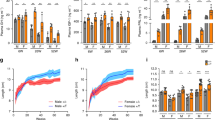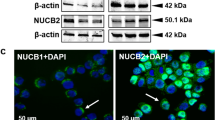Abstract
We have examined the influence of insulin-like growth factor I (IGF-1) on prolactin gene expression in rat pituitary GH4C1 cells. Incubation with IGF-1 increases prolactin mRNA levels and activates the prolactin promoter in transient transfection assays. A similar degree of activation is observed with constructs extending to −3000 and −176 base pairs of the prolactin 5′ flanking region, indicating that the IGF-1 response element is located in the proximal promoter sequences. A plasmid containing 101 base pairs shows a partial stimulation by IGF-1, and the response is lost in a deletion to −76 base pairs. The Ras oncoproteins have been implicated as a critical signaling component in mediating the effect of growth factor receptor tyrosine kinases. Expression of oncogenic RasVal12 mimics the effect of IGF-1 on the prolactin promoter, and a dominant negative Ras, RasAsn17, blocks IGF-1-mediated stimulation. Dominant negative mitogen-activated protein kinase (MAPK) also reduces the activation of the prolactin promoter by IGF-1. Ets transcription factors have been described to lie downstream of Ras and MAPK in the signaling pathway leading to prolactin gene activation. Mutation of two Ets binding sites in the promoter region between −101 and −76 abolishes the response to IGF-1. Furthermore, a dominant negative Ets vector strongly reduces the response of the prolactin promoter to IGF-1 and Ras. The endogenous concentration of Ets-related proteins is not limiting in GH4C1 cells for the IGF-1 effect. However, c-Ets-1 and GHF-1 act synergistically in HeLa cells with the IGF-1 receptor, reconstituting pituitary IGF-1 responsiveness. The response to IGF-1 in GH4C1 cells is still observed after transfection with RasVal12 suggesting that, although Ras is required, IGF-1 could stimulate other pathway/s in addition to Ras. Wortmanin, an inhibitor of phosphatidylinositol-3 kinase (Pl-3 kinase), also prevents the response of the prolactin promoter to IGF-1. These results show that both the Ras/MAPK/Ets pathway, as well as the activation of Pl-3 kinase are involved in the signaling mechanism leading to prolactin expression by IGF-1 in GH4C1 cells.
This is a preview of subscription content, access via your institution
Access options
Subscribe to this journal
Receive 50 print issues and online access
$259.00 per year
only $5.18 per issue
Buy this article
- Purchase on Springer Link
- Instant access to full article PDF
Prices may be subject to local taxes which are calculated during checkout
Similar content being viewed by others
Author information
Authors and Affiliations
Rights and permissions
About this article
Cite this article
Castillo, A., Tolon, R. & Aranda, A. Insulin-like growth factor-1 stimulates rat prolactin gene expression by a Ras, ETS and phosphatidylinositol 3- kinase dependent mechanism. Oncogene 16, 1981–1991 (1998). https://doi.org/10.1038/sj.onc.1200204
Received:
Revised:
Accepted:
Published:
Issue Date:
DOI: https://doi.org/10.1038/sj.onc.1200204
Keywords
This article is cited by
-
Olfactory marker protein regulates prolactin secretion and production by modulating Ca2+ and TRH signaling in lactotrophs
Experimental & Molecular Medicine (2018)
-
PI3K/Akt/mTOR pathway involvement in regulating growth hormone secretion in a rat pituitary adenoma cell line
Endocrine (2018)
-
Cell type influences the molecular mechanisms involved in hormonal regulation of ERG K+ channels
Pflügers Archiv - European Journal of Physiology (2012)
-
Type 1 insulin-like growth factor regulates MT1-MMP synthesis and tumor invasion via PI 3-kinase/Akt signaling
Oncogene (2003)
-
Ets target genes: past, present and future
Oncogene (2000)



